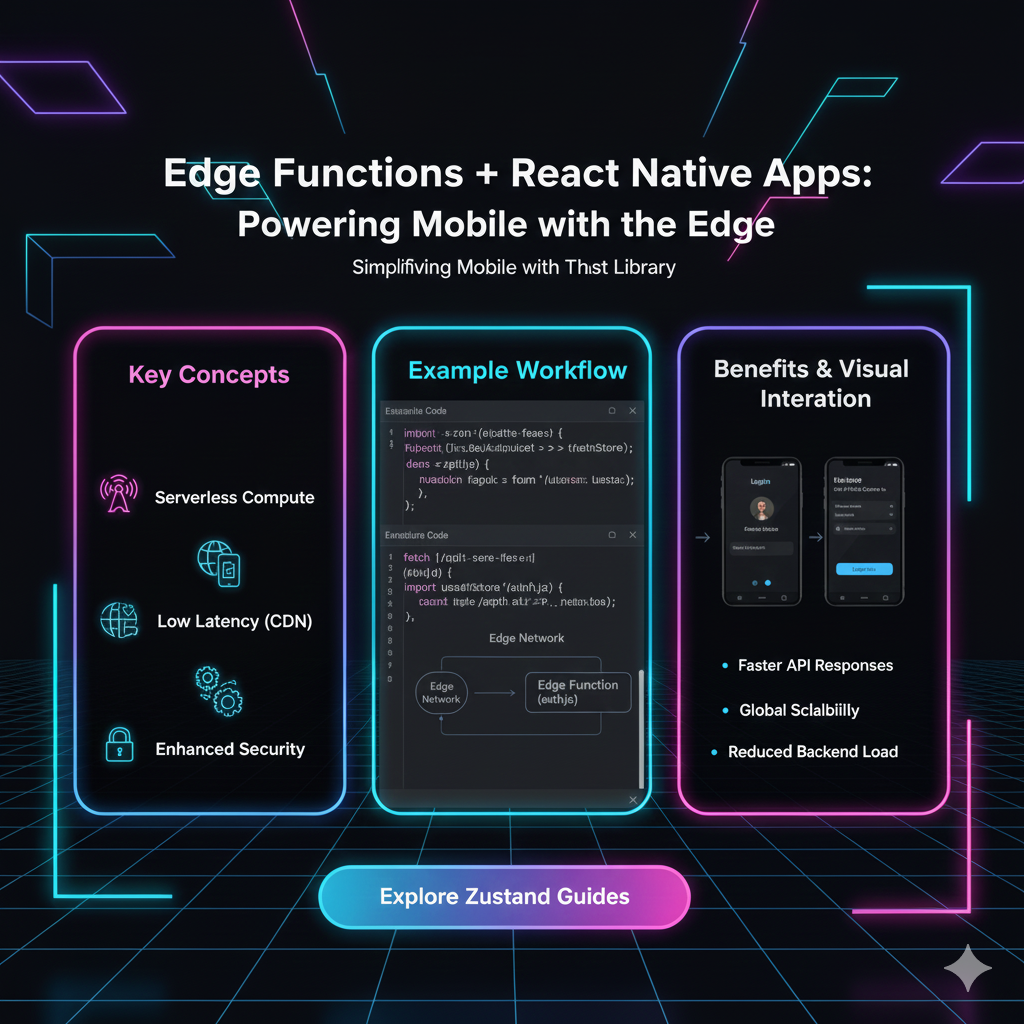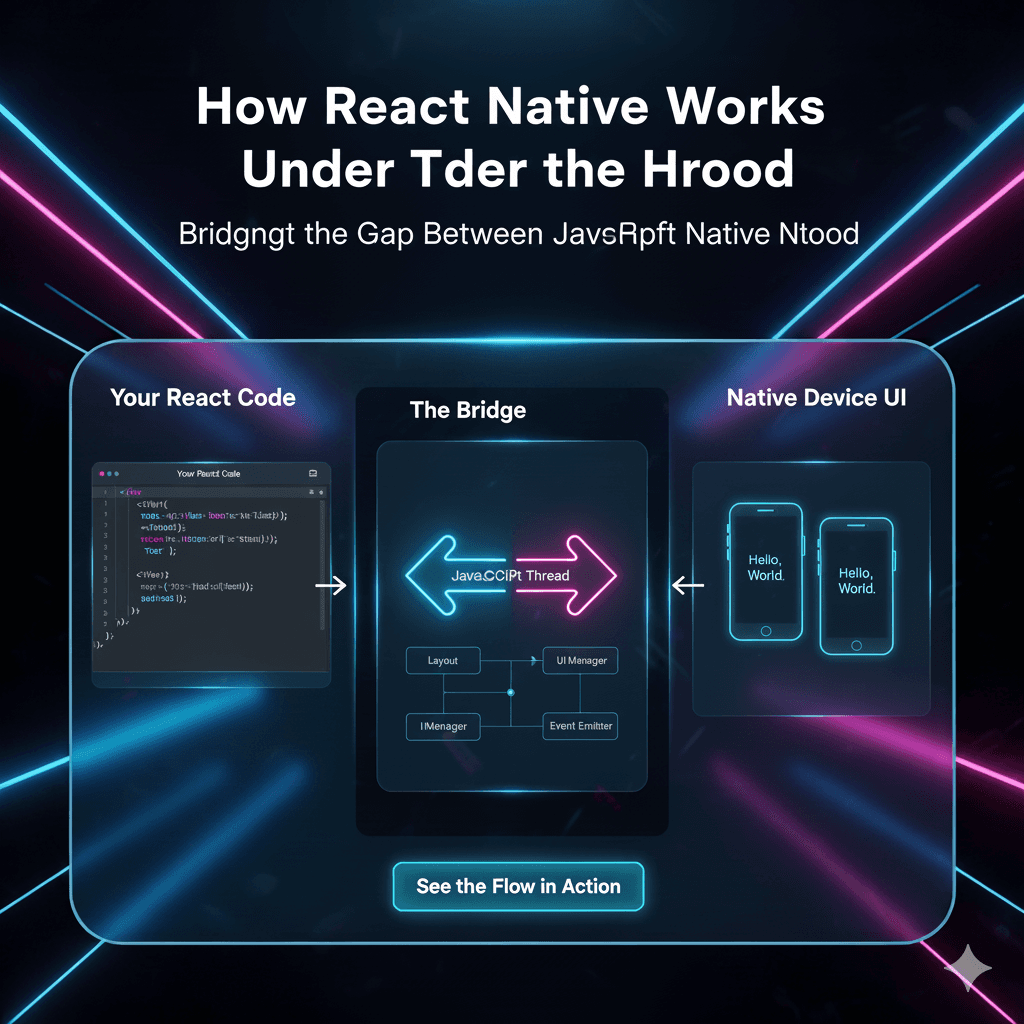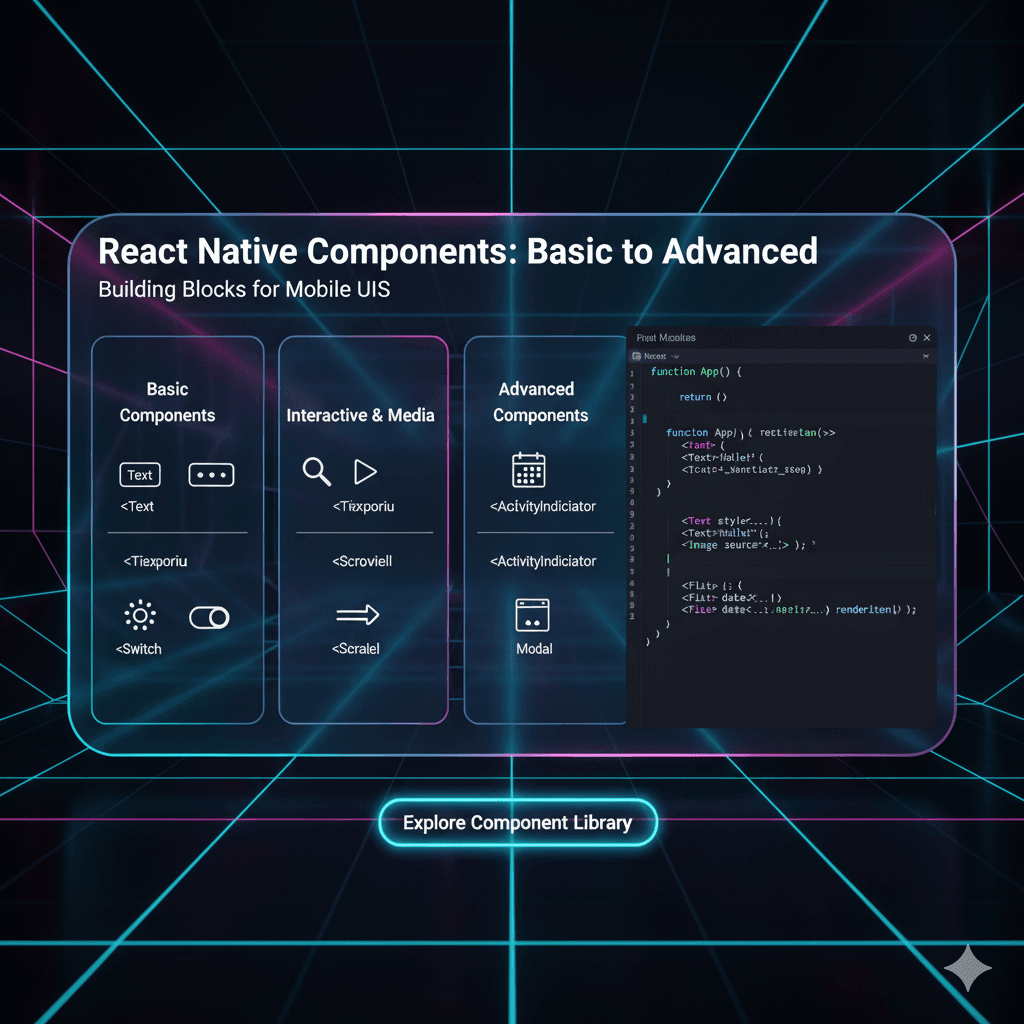Edge Functions & React Native: Supercharge Your Mobile Apps

Tired of slow mobile apps? Learn how to combine React Native with Edge Functions for blazing-fast, scalable, and secure applications. Real-world examples & best practices inside.

Edge Functions & React Native: Supercharge Your Mobile Apps
Edge Functions + React Native: The Secret Sauce for Blazing-Fast Mobile Apps
Let's be real. We live in a world of zero patience. If your mobile app takes more than a couple of seconds to load, show relevant content, or respond to a user's action, you've probably already lost them. They're off to the next thing, and your uninstall rate just ticked up.
As React Native developers, we've got an amazing toolkit for building cross-platform apps. But for too long, we've been shackled to the traditional "client-server" model where our backends, often sitting in a single data center thousands of miles away, become the bottleneck.
What if I told you there's a way to cut down those API response times from 500ms to under 50ms? What if you could make your app feel instant, even for users on the other side of the planet?
Enter Edge Functions. This isn't just another tech buzzword; it's a genuine paradigm shift. And when you pair it with React Native, you unlock a new tier of performance and user experience.
In this deep dive, we're going to break down exactly what Edge Functions are, why they're a game-changer for mobile apps, and how you can start using them in your React Native projects today.
Alright, But What Exactly Are Edge Functions?
Let's ditch the complex jargon. Imagine your traditional backend API is a famous chef working out of one central kitchen in, say, Mumbai. If you're in Delhi and order food, it has to be prepared and then transported all the way from Mumbai. It takes time, right?
Now, imagine instead that this famous chef could instantly teleport their skills and recipes to a cloud kitchen right in your neighborhood. Your order is prepared locally and delivered in minutes. That's the core idea behind Edge Functions.
Technically, Edge Functions are small pieces of code that are deployed to a globally distributed network of data centers (the "edge") and run closer to your users. They are serverless, meaning you don't manage servers, and they execute in response to network events.
Key Providers: You've probably heard of them:
Vercel Edge Functions
Cloudflare Workers
AWS Lambda@Edge
Netlify Edge Functions
Why Should You, a React Native Dev, Care?
Think about the common pain points in a React Native app:
Slow API Calls: The dreaded spinner. Users hate it.
High Latency for Global Users: Your app might be fast for you, but what about users in a different continent?
Security Concerns: Putting API keys and sensitive logic on the client is a big no-no.
Complex Backend Logic for Simple Tasks: Do you really need to wake up your entire backend server just to validate a form or tailor some content?
Edge Functions solve these by moving the logic closer to the user. This results in:
Insanely Low Latency: We're talking milliseconds. The response is served from a data center that's probably just a few miles from your user.
Massive Scalability: The edge network automatically scales with traffic. No more "Reddit hug of death" anxiety.
Enhanced Security: Keep sensitive logic and API keys on the edge, away from the client-side code.
Improved User Experience: Faster loads, instant responses. A happy user is a retained user.
Real-World Use Cases: Making Your React Native App Shine
Enough theory. Let's get practical. How can you actually use this in your app?
Use Case 1: Personalized Content & A/B Testing at the Edge
The Scenario: You have a React Native news app. You want to show a different featured story or banner based on the user's location or whether they are part of a new A/B test group.
The Old Way: Your app makes a call to your central server /api/homepage-content. The server figures out the user's location from their IP, queries the database for the right content, and sends it back. This is slow and puts load on your primary server.
The Edge Way:
Your React Native app makes a request to an Edge Function URL, e.g.,
https://myedge.app/api/personalized-feed.The Edge Function, running near the user, instantly reads the user's IP address to determine their country/city.
It can quickly check a fast edge storage (like KV store) for the relevant content or A/B test configuration.
It returns the tailored JSON response to the app almost instantly.
The user gets a personalized experience without the round-trip lag. The code for the Edge Function (using Cloudflare Workers syntax) would look something like this:
javascript
// Cloudflare Worker Example
export default {
async fetch(request, env) {
const country = request.cf.country; // Get country from request
let featuredStory;
switch (country) {
case 'US':
featuredStory = { title: 'US Election Update', id: 123 };
break;
case 'IN':
featuredStory = { title: 'Monsoon Season Forecast', id: 456 };
break;
default:
featuredStory = { title: 'Global News Roundup', id: 789 };
}
return new Response(JSON.stringify({ featuredStory }), {
headers: { 'Content-Type': 'application/json' },
});
},
};Use Case 2: Supercharging Authentication & Security
The Scenario: You're using an external API (like Twitter, Stripe, or a weather service) that requires an API key. You should never store this key in your React Native app bundle—it's easily exposed.
The Edge Way: The Edge Function acts as a secure proxy.
Your React Native app sends a request to your Edge Function:
https://myedge.app/api/weather?city=Delhi.The Edge Function securely holds the actual Weather API key. It adds this key to the request and forwards it to the real weather API:
https://realweatherapi.com?city=Delhi&api_key=YOUR_SECRET_KEY.The Edge Function gets the response, can even transform or filter the data (e.g., only send the fields your app needs), and then sends the clean, safe data back to your React Native app.
Your secret key never leaves the secure edge environment. You also save bandwidth by sending only the necessary data to the mobile device.
Use Case 3: Lightweight Image Optimization & Transformation
The Scenario: Users in your social React Native app upload profile pictures. You need to display these images in different sizes and formats (WebP for Android, AVIF for supported browsers, etc.) for optimal performance.
The Old Way: You'd need a complex serverless function or a dedicated server running ImageMagick to process images on-demand, which can get expensive and slow.
The Edge Way: Providers like Cloudflare offer built-in image resizing at the edge. Your React Native app can simply request the image with parameters in the URL.
https://myedge.app/cdn/avatars/user123.jpg?width=100&height=100&format=webp
The Edge Function intercepts this request, fetches the original image, resizes/optimizes it on the fly at the edge location, and serves it. This is incredibly fast and reduces the processing load on your origin server.
Best Practices for Using Edge Functions with React Native
Jumping in is exciting, but do it right:
Keep Them Lightweight: Edge Functions are meant to be fast, short-lived tasks. Don't put CPU-intensive, long-running processes in them. The cold start time is minimal, but keep your code lean.
Use for Specific Tasks: They are not a replacement for your entire backend. Use them for specific, high-performance needs like authentication, personalization, routing, or data aggregation.
Manage State Wisely: Edge Functions are typically stateless. For data that needs to persist, use edge storage solutions (like Cloudflare KV, Vercel Blob) or connect to your traditional database, but be mindful of the connection latency.
Error Handling is Key: Your React Native app must gracefully handle scenarios where the Edge Function might fail. Implement robust error handling and fallbacks in your
fetchcalls.Secure Your Endpoints: Just because it's on the edge doesn't mean it's open. Use middleware in your Edge Functions for JWT verification, rate limiting, and CORS configuration specific to your app's bundle identifier.
FAQs: Clearing the Air
Q: Can I replace my entire Node.js/Express backend with Edge Functions?
A: Not entirely. They are perfect for request/response logic that benefits from low latency. However, for persistent connections (WebSockets), very long-running jobs, or complex database-heavy operations, a traditional backend or serverless functions in a single region might still be better.
Q: Doesn't this get expensive?
A: It's surprisingly cost-effective. Most providers have a massive free tier (often hundreds of thousands of requests per day). You only pay for what you use beyond that, and since the functions are lightweight, the execution costs are low.
Q: How do I debug an Edge Function?
A: This has improved massively. Providers offer detailed logging dashboards that show you the execution of your function, including console.log statements, for every request. You can see which edge location it ran from and exactly what happened.
Q: Is the learning curve steep?
A: If you know JavaScript/TypeScript, you're 90% there. The APIs are specific to the provider, but they are simple and well-documented. You'll feel at home very quickly.
Conclusion: The Future is at the Edge
The combination of React Native and Edge Functions is a powerhouse. It allows us to build mobile applications that are not just functional, but truly delightful. By moving critical pieces of logic closer to our users, we eliminate the biggest bottleneck in modern app performance: distance.
This is no longer a niche or "future" technology—it's readily available and incredibly powerful. The performance gains are not just incremental; they are transformational.
To truly master modern full-stack development and build cutting-edge applications that leverage technologies like React Native, Edge Functions, and more, you need a structured learning path. To learn professional software development courses such as Python Programming, Full Stack Development, and the MERN Stack, visit and enroll today at codercrafter.in. Our project-based curriculum is designed to take you from beginner to industry-ready, teaching you how to integrate these advanced concepts into real-world applications.
So, what are you waiting for? Pick a provider, deploy your first "Hello World" Edge Function, and call it from your React Native app. Feel the speed for yourself. Your users will thank you for it.








